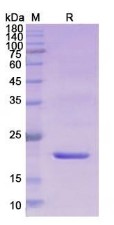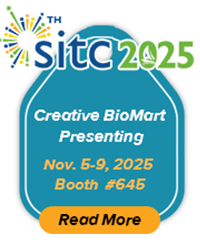RLN2
-
Official Full Name
relaxin 2 -
Overview
Relaxins are known endocrine and autocrine/paracrine hormones, belonging to the insulin gene superfamily. In the human there are three non-allelic relaxin genes, RLN1, RLN2 and RLN3. RLN1 and RLN2 share high sequence homology. The active form of the encoded protein consists of an A chain and a B chain but their cleavage sites are not definitely described yet. Relaxin is produced by the ovary, and targets the mammalian reproductive system to ripen the cervix, elongate the pubic symphysis and inhibit uterine contraction. It may have additional roles in enhancing sperm motility, regulating blood pressure, controlling heart rate and releasing oxytocin and vasopressin. There are two alternatively spliced transcript variants encoding different isoforms described for this gene. -
Synonyms
RLN2;relaxin 2;H2;RLXH2;bA12D24.1.1;bA12D24.1.2;relaxin 2 (H2);prorelaxin H2;relaxin H2;relaxin, ovarian, of pregnancy;Relaxin B chain;Relaxin A chain;OTTHUMP00000021027;OTTHUMP00000196912
Recombinant Proteins
- Human
- Rhesus macaque
- Pig
- E.coli
- Mammalian Cells
- HEK293
- Non
- His
- Avi
- Fc
| Cat.# | Product name | Source (Host) | Species | Tag | Protein Length | Price |
|---|---|---|---|---|---|---|
| RLN2-172H | Recombinant Human Relaxin 2 | E.coli | Human | Non |
|
|
| RLN2-173H | Recombinant Human Relaxin 2 | E.coli | Human | Non |
|
|
| RLN2-220H | Recombinant Full Length Human RLN2 Protein, His-tagged | E.coli | Human | His | Full L. |
|
| RLN2-3904R | Recombinant Rhesus monkey RLN2 Protein, His-tagged | Mammalian Cells | Rhesus macaque | His |
|
|
| RLN2-7081H | Recombinant Human RLN2, His-tagged | E.coli | Human | His | 25-185aa |
|
| RLN2-2672P | Recombinant Pig RLN2 Protein, His-tagged | E.coli | Pig | His | Gln25-Cys182 (Accession # P01348) |
|
| RLN2-3721R | Recombinant Rhesus Macaque RLN2 Protein, His (Fc)-Avi-tagged | HEK293 | Rhesus macaque | Avi&Fc&His |
|
|
| RLN2-3721R-B | Recombinant Rhesus Macaque RLN2 Protein Pre-coupled Magnetic Beads | HEK293 | Rhesus macaque |
|
||
| RLN2-6180H | Recombinant Human RLN2 Protein (Val23-Cys185), N-His tagged | E.coli | Human | His | Val23-Cys185 |
|
Background
What is RLN2?
The Relaxin 2 protein (RLN2) is a peptide hormone pertaining to the insulin superfamily, comprising of 53 amino acid residues. Proposed initially in the 1920s, Relaxin was initially deemed a hormone related to pregnancy since it was found in the ovaries of pregnant pigs. However, it was not until the 1970s that the presence of this hormone was verified in humans. The RLN2 gene was discovered in the early 1990s following some in-depth research, culminating in its being cloned successfully.
On the matter of the human genome, the RLN2 gene is situated on chromosome 9 at the gene locus of 9p24.1, between 8,052,709 and 8,063,997 base pairs. The structure of RLN2 protein predominantly falls into insulin/IGF/relaxin family with two insulin-like disulphide bonds forming distinct domains (A and B chains). A smaller C chain further links these two domains, creating the hallmark 'hinge' region.
What Is The Function of RLN2 Protein?
Delving into the function of RLN2 protein, it is predominantly known for its role in pregnancy. It interacts with the LGR7 and LGR8 receptors on the uterine wall to facilitate the onset of labor by relaxing the uterine musculature. Furthermore, RLN2 also contributes to changes in the collagen content in the cervix, enabling dilation. Besides, Relaxin also has vasodilatory properties essential for cardiovascular and renal function, enhancing blood flow to organs during pregnancy.
Beyond its role in reproduction, the RLN2 protein also plays an intriguing role in signal pathways mediating various physiological functions. Its primary signaling pathway involves binding to the G-protein-coupled receptors RXFP1 and RXFP2. This interaction triggers the activation of adenylyl cyclase, stimulating cyclic AMP production, and activating the crucial PKA and PI3K/AKT signaling pathways. These cascades mediate RLN2's actions on fibrosis, inflammation, angiogenesis, and also play a part in cancer progression.
RLN2 Protein Related Diseases
Interestingly, abnormalities or alterations in the RLN2 protein can contribute to several diseases. Elevated levels of RLN2 protein have been associated with heart failure, with the protein apparently counteracting multiple facets of heart disease, including hypertrophy, fibrosis, and apoptosis. RLN2 protein has also been implicated in various cancers, including breast, thyroid, and prostate cancer, owing to its roles in angiogenesis and tumorigenesis.
Furthermore, RLN2 protein has been found to be overexpressed in fibrotic diseases like liver cirrhosis and pulmonary fibrosis owing to its antifibrotic activities. This connection places RLN2 protein as a potential therapeutic target for these disorders. RLN2 has also been associated with pre-eclampsia, a pregnancy disorder characterized by high blood pressure and organ damage, with altered levels of the protein indicating the severity of the condition.
RLN2 Protein's Applications
The versatility of RLN2 protein and its wide range of potential applications make it a promising avenue for therapeutic strategies. In cardiology, RLN2 has been utilized as a biomarker for heart failure severity. A recombinant form of human RLN2, Serelaxin, has undergone clinical trials for acute heart failure treatment and potentially could be beneficial in alleviating symptoms of this life-threatening condition. Moreover, its antifibrotic properties highlight it as a therapeutic candidate for fibrotic diseases like liver cirrhosis. In oncology, RLN2 could be a target for therapeutic intervention, given its implications in tumor growth.
In conclusion, RLN2 protein, as an intrinsic component of the human genome, contributes significantly to a repertoire of physiological processes in the human body. Despite its discovery decades ago, continued exploration into its signaling pathways, influence on disease progression, and potential therapeutic applications remains richly valuable. Increasing our understanding of RLN2 protein could stipulate advancements in disease detection, management, and effective therapeutic strategies, thereby enriching the palette of human health care.
Case Study
Case 1: Ma J, et al. Biomed Res Int. 2015.
The aim of the study was to determine the effect of H2 relaxin (RLN2) on invasion, migration, and chemosensitivity to cisplatin in human osteosarcoma U2-OS and MG-63 cells and then to investigate the effect of RLN2 on the AKT/NF-κB signaling pathway.
These results indicated RLN2 confers to migratory and invasive ability, angiogenesis, and chemoresistance to cisplatin via modulating the AKT/NF-κB signaling pathway in vitro.

Fig1. Western blot assay for RLN2, RXFP1, AKT, ERK1/2, p-Akt, and p-ERK1/2 in OS tissues with pulmonary metastatic disease.

Fig2. Expression of RLN2 in OS cells following different treatment. (a) The expression of RLN2 protein was measured by western blot in MG-63 cells with specific siRNA transfection. The result showed that RLN2 was significantly blocked in positive groups compared with control group. (b) U-2OS cells were treated with 100 nM recombinant relaxin for 24 hs. The expression of RLN2 protein was measured by western blot in MG-63 cells. The result showed that RLN2 was significantly increased in positive groups compared with control group.
Case 2: Azam A, et al. J Immunol. 2019.
H2-relaxin (RLN2) is a two-chain peptide hormone structurally related to insulin with a therapeutic potential in multiple indications. However, multiple injections of human RLN2 induced anti-RLN2 Abs in patients, hampering its clinical development.
The article quantified the RLN2-specific T cell repertoire using PBMCs collected from healthy donors. CD4 T cells were stimulated in multiple replicates by weekly rounds of stimulation by dendritic cells loaded with RLN2, and their specificity was assessed by IFN-γ ELISPOT.
Their results provide important clues to the immunogenicity of RLN2 and highlight the weak central immune tolerance induced against this self-hormone.

Fig1. Generation of RLN2-specific CD4 T cells from healthy individuals. T cell lines (T cells contained in a single well) were generated by three weekly rounds of stimulation with RLN2 or KLH, and their specificity was tested by IFN-γ ELISPOT with autologous DCs alone (Ctrl) or with DCs previously loaded with RLN2 or KLH. (A) RLN2-specific T cell lines generated from donor 329.
Case 3: Hampel U, et al. Invest Ophthalmol Vis Sci. 2012.
The study aimed to determine if the insulin-like peptide hormone relaxin 2 (RLN2) is expressed at the ocular surface and in tears and if RLN2 influences wound healing at the ocular surface, which is associated with extracellular matrix (ECM) remodeling.
The autors analyzed effects of human RLN2 on cell proliferation and migration and quantified mRNA expression of matrix metalloproteinases (MMPs) and tissue inhibitors of metalloproteinases (TIMPs) in HCE, HCjE, and SC.
Fig1. Nonradioactive BrdU proliferation assays on human sebaceous (SC) (A), conjunctival (HCjE) (B), and corneal (HCE) (C) cell lines exposed to 100 ng/mL and 500 ng/mL RLN2 for 24 hours.
Quality Guarantee
High Purity

Fig1. SDS-PAGE (Cat. No.: RLN2-6180H)(Val23-Cys185)
Involved Pathway
RLN2 involved in several pathways and played different roles in them. We selected most pathways RLN2 participated on our site, such as Class A/1 (Rhodopsin-like receptors),G alpha (s) signalling events,GPCR downstream signaling, which may be useful for your reference. Also, other proteins which involved in the same pathway with RLN2 were listed below. Creative BioMart supplied nearly all the proteins listed, you can search them on our site.
| Pathway Name | Pathway Related Protein |
|---|---|
| GPCR downstream signaling | ARHGEF25,ARHGAP4,S1PR3,ADCYAP1B,ECT2,DGKA,OXER1,PYY,EDN1,APLN |
| Signaling by GPCR | GPR4,RAMP2,ZFPM2B,EMR3,GHRH,CCL35.1,EMR1,SST1.1,OPN5,RGS7 |
| Peptide ligand-binding receptors | QRFPR,KEL,FPR-RS6,PNOC,NPS,GPR37B,CCL35.2,SSTR5,CCL35.1,UTS2D |
| Signal Transduction | FGFBP3,IRBP,PROK1,NMT1A,IGF2BP1,APOM,LGR5,LINGO1B,ROR1,OPN4B |
| GPCR ligand binding | OPN1MW,CCR1,OPN4.1,CRHB,ACKR4,CCRL2,APLN,AMCF-II,PTH,RCA2.1 |
| Relaxin receptors | RLN3,INSL3,RLN3A,RXFP2,INSL5 |
| G alpha (s) signalling events | CRHR1,NPSR1,ADORA2A,ADM2A,POMCB,CRH,GHRH,ADCYAP1,RAMP2,RLN3 |
| Class A/1 (Rhodopsin-like receptors) | EDNRA,CHRM1,SST,GPR17,OPN1LW1,OPN4,ADORA3,TAC2,ADRA2C,S1PR5B |
Protein Function
RLN2 has several biochemical functions, for example, hormone activity. Some of the functions are cooperated with other proteins, some of the functions could acted by RLN2 itself. We selected most functions RLN2 had, and list some proteins which have the same functions with RLN2. You can find most of the proteins on our site.
| Function | Related Protein |
|---|---|
| hormone activity | GCGB,IGF2,RLN3,VIP,POMCB,SMTLB,PRL3B1,GNRH1,TTR,BMP10 |
Interacting Protein
RLN2 has direct interactions with proteins and molecules. Those interactions were detected by several methods such as yeast two hybrid, co-IP, pull-down and so on. We selected proteins and molecules interacted with RLN2 here. Most of them are supplied by our site. Hope this information will be useful for your research of RLN2.
Resources
Related Services
Related Products
References
- Arroyo, JI; Hoffmann, FG; et al. Evolution of the Relaxin/Insulin-Like Gene Family in Anthropoid Primates. GENOME BIOLOGY AND EVOLUTION 6:491-499(2014).
- Rocha, FG; Slavin, TP; et al. Genetic associations of relaxin: preterm birth and premature rupture of fetal membranes. AMERICAN JOURNAL OF OBSTETRICS AND GYNECOLOGY 209:-(2013).



